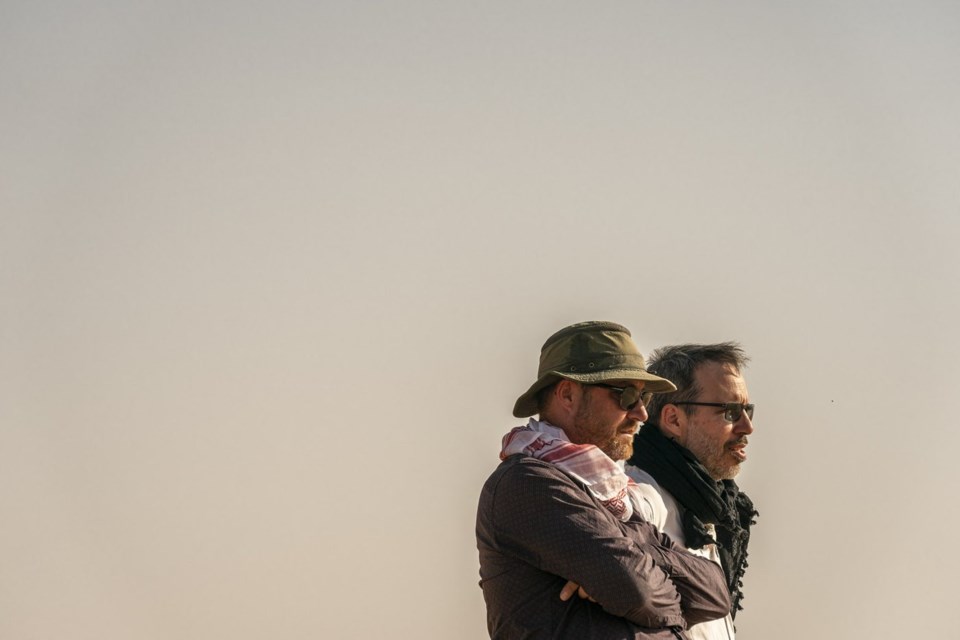Production designer Patrice Vermette already has an Oscar for his work on the first instalment of the sand-swept sci-fi epic ŌĆ£Dune,ŌĆØ but he says earning another nomination for the elaborate sequel is ŌĆ£still overwhelming.ŌĆØ
Reached recently in Budapest, the Montreal artist rattled off a whirlwind of events he planned to attend the moment he lands Friday in Los Angeles, where near back-to-back gatherings lead up to Sunday's televised gala.
ŌĆ£You're floating on a cloud, basically," Vermette says of Academy Awards fanfare, which started with a flood of calls, texts and well-wishes on nomination day.
On Sunday, he and ŌĆ£Dune: Part TwoŌĆØ set decorator Shane Vieau of Dartmouth, N.S., compete for the production design trophy against teams from ŌĆ£The Brutalist,ŌĆØ ŌĆ£Conclave,ŌĆØ ŌĆ£Nosferatu,ŌĆØ and ŌĆ£Wicked.ŌĆØ
ŌĆ£Dune: Part Two,ŌĆØ directed by Denis Villeneuve, is also up for best sound, visual effects, cinematography and best picture, a marquee prize for producers that would go to Mary Parent, Cale Boyter and Canadian filmmakers Tanya Lapointe and Villeneuve.
In concocting the eye-popping visuals from Frank HerbertŌĆÖs novel, Vermette said he took direction from the story itself and the characters that inhabit its strange worlds ŌĆō among them, the desert planet of Arrakis where massive killer worms lurk beneath the sand, and the eerie black-and-white landscape of Giedi Prime, ruled by a black sun.
If you want to make sci-fi and fantasy designs believable itŌĆÖs "important to anchor things into a reality," says Vermette, previously nominated for VilleneuveŌĆÖs alien-invasion film ŌĆ£Arrival,ŌĆØ which featured massive oval spaceships and the squid-like heptapod visitors.
ŌĆ£I think design should be a response or a conversation with the elements in which that set exists. I try to put myself in the shoes of the architect,ŌĆØ he says, pointing to the Arrakis city of Arrakeen, where winds blow at 850 kilometres an hour.
ŌĆ£So would I build anything straight? No, I would build everything at an angle. And then, OK, there's worms that go on a killing spree if there's any vibration or rhythm, so I would not build anything in the sand dunes. I would try to anchor the city into probably a rock, because that's pretty safe, the sandworms don't go there."
A world with intense desert heat meant Arrakis interiors needed thick walls that retain humidity and coolness. Those spaces should also avoid direct sunlight, so Vermette's set features a system of light wells to illuminate the indoors.
ŌĆ£It's all in the book but the great thing about Frank Herbert's writings is that he doesn't give all the answers. He just gives these clues and leaves it to the imagination of the reader. But the clues are there."
For the relatively lush imperial planet of Kaitain, Vermette turned to the architecture of Italian designer Carlo Scarpa for inspiration, even urging Villeneuve to shoot at ScarpaŌĆÖs Brion Sanctuary, to introduce the emperor and princess, played by Christopher Walken and Florence Pugh.
ŌĆ£Nobody had ever shot there before. They always turned down films. But when they learned I was from ŌĆśDune,ŌĆÖ and they loved Part One, they said, 'Well, maybe we're interested in meeting,ŌĆÖŌĆØ he says of the architectural masterpiece in San Vito d'Altivole, near Treviso.
ŌĆ£It's actually the first location in 30-some years that I'm doing this that I actually cried when I visited. It's so beautiful. The attention to details of that place is beyond words.ŌĆØ
Fond of playing with space, scale, and proportions, Vermette describes his approach as a ŌĆ£bit like a DJ ŌĆö you need to create a rhythm to make the journey interesting," a callback to his original ambitions of becoming a record producer.
ŌĆ£It's about not necessarily revealing all of a sudden everything," he says. ŌĆ£You discover something. Then you turn a corner, and oh, there's another beat."
Vermette says he studied sound design in school, imagining he might score films one day. He volunteered as a production assistant on commercials and music videos, thinking it could help jumpstart his music career.
It wasnŌĆÖt until he was enlisted to replace a slacking production designer on a music video that he found his true calling. That free gig led to another and another, where he had the freedom to learn on the job, he says.
Vermette credits meeting the late Jean-Marc Vall├®e with catapulting his career, going on to work on Vallee's "C.R.A.Z.Y.," "The Young Victoria" and "Caf├® de Flore." He also forged a tight bond with Villeneuve, for whom he also worked on "Enemy," "Prisoners" and "Sicario."
Now heŌĆÖs got an eye on yet another field ŌĆō architecture. Vermette says heŌĆÖs collaborating with an international firm to build luxury hotels in Saudi Arabia, "which has been challenging and fun."
He won't reveal the work that brought him to Budapest, but says Montreal remains his home.
"That's my oasis. I know I would never leave Montreal," he says. "Actually, right now I'm missing the snow we have in Montreal."
This report by The Canadian Press was first published Feb. 25, 2025.
Cassandra Szklarski, The Canadian Press




